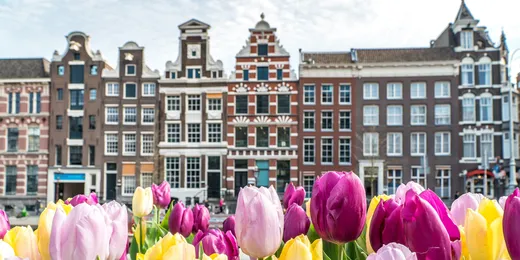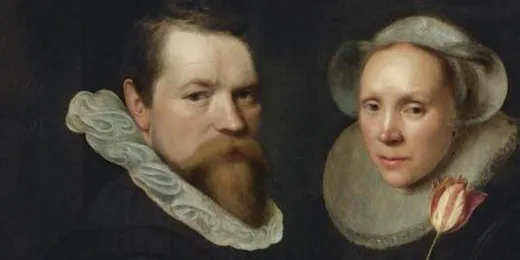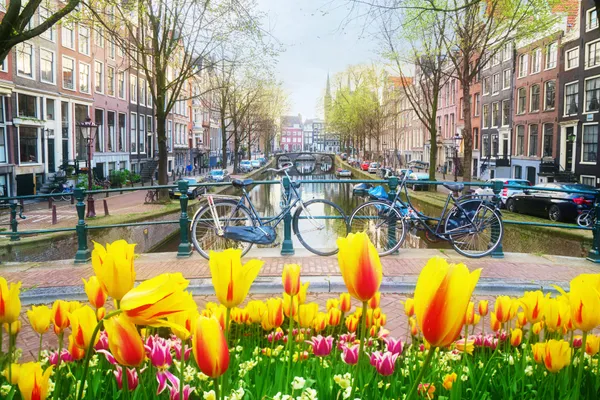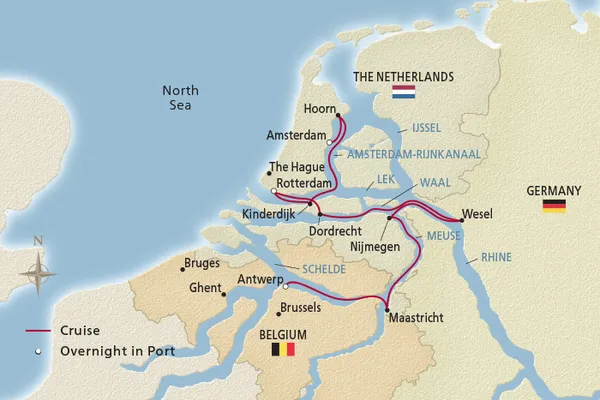
Experience the wonder of tulip season
With mild weather and colorful flowers in bloom, spring is an ideal time for curious travelers to explore the Low Countries. Read on to discover a crispy Dutch snack, delve into the storied past of Antwerp and learn about the captivating history of WWII’s Operation Garden Market.

Tulip Season
Tulips originated in Central Asia and are believed to have been cultivated for more than 1,000 years. The English word “tulip” is derived from the Persian word delband, which means “turban,” a nod to the flower’s distinctive shape.
The tulip was introduced to Europeans in 1554, when the Ottoman Empire gifted seeds and bulbs to a European ambassador. In turn, the ambassador gave them to Roman emperor Ferdinand and his royal botanist, Carolus Clusius. The botanist’s careful study of tulip cultivation laid the foundation for the modern bulb industry. One of Clusius’s contemporaries described him as the “father of all the beautiful gardens in Europe.”
Sometime after their introduction to the Netherlands, tulips contracted a non-fatal virus that created splashes of color along their petals in a wide variety of unpredictable patterns—contributing to both their appeal and their market value.
Despite their Central Asian roots, the climate of the Netherlands is ideal for tulip cultivation. Best grown in maritime regions, tulips thrive in the sandy-clay soils near the coast of the North Sea. Springtime precipitation levels (2.5"–3.5" per month) ensure that the flowers receive plenty of water, while mild winters—averaging 35-40°F (2-4°C)—offer the cool temperatures bulbs require without being too harsh.
During the 1600s, tulips famously disrupted the Dutch economy. The waxy flower became so wildly popular that they sparked a speculative trading frenzy known as “tulip mania.” At the peak of tulip mania, some individual bulbs sold for more than ten times the annual income of a skilled craftsman, and a valuable bulb could change hands up to ten times a day. One Viceroy tulip bulb was worth all the following:
- Two sheaves of wheat
- Four sheaves of rye
- Four fat oxen
- Eight fat swine
- Twelve fat sheep
- Two hogsheads of wine
- Four casks of beer
- Two tons of butter
- A complete bed (with mattress and bedding)
- A suit of clothes
- A silver drinking cup
Tulip mania was short-lived, however. When it crashed, so did the fortunes of many tulip investors, creating what economists today consider to be the first speculative bubble.
While tulips may not be quite so economically valuable today, they continue to bring joy and inspiration. Anyone who appreciates the beauties of colorful flora will especially enjoy a visit to Keukenhof Gardens, the world’s largest floral garden. Located in Amsterdam, the 79-acre landscape showcases 7 million bulbs’ worth of radiant beauty.

-
Cuisine—Bitterballen
In the Netherlands, meeting friends at a pub or café often involves enjoying a few drinks alongside a platter of bittergarnituur—a snack assortment that literally translates to “garnish for bitters.” The “bitters” referred to here are bittertje, specifically small glasses of Dutch Jenever or gin, though the word can refer to alcoholic beverages in general. Your bittergarnituur will likely include small cubes of Gouda or Edam cheese, some smoked sausage, salami or gherkins. But the brightest star of this culinary constellation will undoubtedly be the bitterballen—crispy, deep-fried meatballs that are a beloved bar food staple.
Bitterballen are traditionally made from ground beef, but veal and chicken may also be used. The meat is sautéed with onions, parsley and sometimes, finely chopped vegetables like carrots. Then it is seasoned with salt, pepper, nutmeg and occasionally curry. This meat mixture gets thickened with a roux, and stock is added to create a savory gravy. The entire mixture is cooled in the refrigerator for several hours or overnight. Once the mixture congeals, it is scooped into little balls, rolled in bread crumbs and deep-fried till golden brown. They’re typically served with a ramekin of spicy mustard for dipping.
In the first half of the 20th century, making bitterballen at home was an excellent way to transform leftover meat into something tasty and economical. Today, they are mainly served outside the home as a snack with a side of fries, or as part of the bittergarnituur plate. If you are in a hurry and do not have time to linger at a pub, you can often get your bitterballen fix by ducking into a raampje, an automat-style snack bar where food is selected from a wall of tiny glass compartments. Bitterballen are also popular at street carts and food trucks, especially at outdoor markets and festivals.
Though humble in origin, bitterballen have transcended their status as simple bar bites. Enhanced with chorizo, goat cheese, exotic spices, mushrooms or even truffles, they now appear at upscale establishments and receptions as gourmet finger food. Wherever you find your bitterballen, they are best enjoyed piping hot with a chilled glass of Dutch pale lager or witbier.
-
Culture—Antwerp, the unofficial capital of Flanders
Flanders is a county, a region and a language area in northern Belgium. It has played a prominent role in European history since the Middle Ages, when it was among the wealthiest and most urbanized areas of the continent. Today, the official capital of Flanders is Brussels, which also serves as the capital of Belgium. But the unofficial capital of Flanders is Antwerp, widely regarded as the heart and soul of Flemish (Dutch-speaking) culture.
Located just 55 miles from the North Sea on the Scheldt River, Antwerp had already become a major port and trading center by the 13th century. During the 14th century, as Bruges’s tidal inlet began to silt up, Antwerp’s fortunes rose. The city became the region’s preeminent mercantile center, growing rich from the wool trade, banking and the sugar trade. The first diamond was cut here in 1476, and even today, Antwerp is known as the “Diamond Capital of the World.”
Flemish arts and culture also thrived. Antwerp’s painting school produced Flemish masters such as Peter Paul Rubens and Anthony van Dyke. Printing emerged as a key industry, and wealthy citizens spurred a flourishing of fine architecture. As foreign interests were drawn to the city, a cosmopolitan population developed and humanism thrived.
During the Protestant Reformation, Dutch-speaking Antwerp became a center of Protestant activity. This, along with other political and economic factors, prompted war with King Philip II of Spain, who was also the sovereign of the Hapsburg Netherlands. This was the beginning of the so-called Eighty Years War (1566–1648). In 1576, Antwerp was sacked, and some 7,000 citizens were killed in a massacre known as “The Spanish Fury.” Still, the city continued to be a center of the Dutch revolt.
During the Spanish occupation, many of Antwerp’s most privileged residents were called señores, from the Spanish word meaning a “decent” lord. The locals adopted the name but gave it a Flemish twist, changing it to Sinjoren. This name is still proudly used to describe anyone who was born within the Antwerp city limits. Some have an even stricter criteria, claiming that to be a true Sinjoor you must have been born in the vicinity of the old Spanish fort, between the De Leien neighborhood and the Scheldt River. Ultimately, the title is more a matter of identity than geography—an expression of the intense pride Sinjoren feel for their Flemish hometown.
-
History—Operation Market Garden
By September 1944, three months after the D-Day landings at Normandy, Allied progress in pushing Nazi troops back to Germany had slowed. The High Command recognized that the Netherlands’ vast network of Rhine River tributaries and canals presented imposing obstacles. Securing the bridges would allow the Allies to continue their advance and, hopefully, end the war by Christmas.
One of World War II’s most dramatic undertakings, Operation Market Garden was devised to seize multiple bridges simultaneously, thereby overwhelming German forces and preventing them from securing alternate crossings. Under a two-pronged strategy, Operation Market dropped American, British and Polish paratroopers from the sky to secure sites around eight Dutch bridges. Meanwhile, Operation Garden utilized British ground forces, hoping to solidify gains bridge by bridge until the Allies had secured the last bridge in Arnhem—later immortalized in the 1977 film A Bridge Too Far.
On September 17, over 20,000 men parachuted in, joined by more than 14,500 troops arriving via military glider. The Allies, believing the German forces to be in retreat, calculated that their 64-mile (103 km) ground advance would take just four days. Meanwhile, the Reich’s fractured infantry was regrouping near Arnhem. Though Allied intelligence and members of the Dutch resistance had reported this buildup, the commanding British General Frederick Browning still decided to move ahead.
Ultimately, the battle-filled march to Arnhem took nine days instead of four. The Allies emerged victorious at Nijmegen’s Waal Bridge after a four-day battle, but by the time they arrived at Arnhem—the last link to crossing the Rhine—they found that their faltering comrades had lost control of the city. After their long advance, they were forced to retreat.
The unexpected resurgence in German strength certainly contributed to the defeat, as did the insufficient reach of the troops’ portable radio transmissions. Furthermore, the delivery of troops and supplies was delayed by poor weather and an aircraft shortage, undermining the Allied plan for using the element of surprise. By the time the Allies had declared victory in Nijmegen, the tide in Arnhem had already turned in favor of the Nazis.
Though history largely remembers Operation Market Garden as a failure, it paved the way for the capture and destruction of the Ludendorff Bridge at Remagen, built during World War I to defend the Rhineland. Its loss dealt a major blow to German morale.
Today, visitors to Arnhem can ride through the fields where paratroopers landed, explore the Airborne Museum to learn about the fateful events of 1944 and witness a reenactment of the Battle of Arnhem. You can also pay homage to the Allied soldiers, as well as Dutch civilians, buried at the Airborne Cemetery at Oosterbeek.
Tulip Season Highlights
The Netherlands and Belgium are renowned for their rich history, artistic treasures and engineering marvels. When you visit in the springtime, you can experience the added joy of seeing lands awash in vibrant color. Here are some of the remarkable sights and activities you may experience on a tulip season journey:
- Explore Keukenhof Gardens, the world’s largest floral park
- See works by the Dutch Masters at Amsterdam’s Rijksmuseum
- Learn about the iconic 18th-century windmills of Kinderdijk
- Visit a tulip farm in the charming village of Slootdorp
- Cycle through the picturesque countryside near Enkhuizen
- Peruse van Gogh’s masterpieces at the Kröller-Müller Museum
- Take in the opulent interiors and gardens of Paleis Het Loo
- Sample a warm, delicious Belgian waffle in Antwerp
- Browse shops in the Royal Gallery of St. Hubert in Brussels
- Discover Bruges’s medieval city center, a UNESCO Site
Destination Insight Videos
-
Exploring Holland - Amsterdam to Kinderdijk (30:48)
Long-time Viking family member and renowned British photographer Alastair Miller begins his journey in Amsterdam, where he reveals the cultural treasures of the Netherlands’s historic capital. Join Alastair as he peruses unique shops (Posthumuswinkel) and a colorful flower market, pedals through the city and visits the owner of a houseboat museum. After stepping on board Viking Kara, one of our award-winning Viking Longships, he sails to Kinderdijk to meet with locals who care for the iconic windmills.
-
Get a glimpse into Amsterdam’s past with guest lecturer Sherry Hutt, PhD (59:03)
Discover the fascinating history of an iconic European city with guest lecturer Sherry Hutt, PhD, who presents “Amsterdam—Eight Centuries Along the Canals.” Founded as a small medieval settlement on the shores of the Amstel River in the Netherlands, Amsterdam later flourished as a center for finance and trade, reaching extraordinary artistic heights during the 17th-century Dutch Golden Age. Discover the origins behind many of the things that Amsterdam—and the Netherlands—is famous for, including tulips and chocolate, as Dr. Hutt shares insights into this canal-laced city.
-
Stroll through the World Famous Keukenhof Gardens in the Netherlands (10:44)
Join us as we journey to Keukenhof Gardens in the Netherlands, considered to be one of the world’s most beautiful spring gardens. During an aerial drone tour, enjoy a bird’s-eye view of its many colorful flower beds filled with tulips, daffodils, hyacinths and many more stunning blossoms—both common and rare. Wander through this magnificent garden when you embark on our 10-day Tulips & Windmills voyage.
-
"Tulip Mania: The Bulb that Sprouted the First Stock Market Bubble" with Russell Lee (59:38)
Learn how tulips created an economic bubble in the 1600s and explore the fascinating story behind the eventual bursting—and financial collapse that followed—throughout the Netherlands and beyond. Once more, we are joined by award-winning writer and lecturer Russell Lee, a master storyteller with a unique, easy-to-understand approach. In this episode, Russell explains the phenomena known as “tulip mania,” and the world-renowned artwork that was created during the Dutch Golden Age.
Tulip Season Travel FAQ
All-Inclusive Itineraries—Tulip Season
Choose one of our enriching, all-inclusive voyages and discover the many benefits of exploring in Viking comfort.














